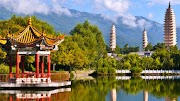Monastery Excursion
A different experience of traveling...
Welcome to the sprawling 100 hectares of rolling hills, plateau, trees, coffee farm, rice field and clusters of building of the Monastery of the Transfiguration --- Benedictine Monks!
Welcome to the sprawling 100 hectares of rolling hills, plateau, trees, coffee farm, rice field and clusters of building of the Monastery of the Transfiguration --- Benedictine Monks!
For a change, instead of introducing beaches and mountain resorts, I will bring you further to the amazing and spectacular countryside of the Monastery of the Transfiguration of the Benedictine Monks. This might sounds absurd to travelers, but did you know that traveling to a monastery is one of the most relaxing and soothing experiences in life? You will not only there to travel and relax with nature but also reassess your life's purpose and mission.
The long winding road.
You can walk on foot from the New Church to the Gift Shop located on top of the hills where the old buildings of the Monastery are located
You can walk on foot from the New Church to the Gift Shop located on top of the hills where the old buildings of the Monastery are located
The breathtaking site of the countryside of the Monastery. The tranquil surroundings with verdant plant and lush green forests provide a fantastic feeling of being relax and at peace
Beautifully Located at San Jose, Malaybalay City, Bukidnon, the monastery is home to more or less 13 Benedictine Monks who personally toiled the lands with the help of lay workers. The area, which is partially covered with trees and plants, is promoting an organic farming particularly on its rice and coffee fields.
The Benedictine Monks are adhering to the congregation’s motto “Ora et Labora” (pray and work) so their lives in the monastery are spent working on the farm and praying (at least seven times a day). The monastery serves flowing brewed coffee 24 hours a day. The monastery has a new building constructed not far from the church and the museum to accommodate the large retinue of retreatants.
The Benedictine Monks are adhering to the congregation’s motto “Ora et Labora” (pray and work) so their lives in the monastery are spent working on the farm and praying (at least seven times a day). The monastery serves flowing brewed coffee 24 hours a day. The monastery has a new building constructed not far from the church and the museum to accommodate the large retinue of retreatants.
What to find at the Monastery?
Here are some of its best features:
The Transfiguration Church
The transfiguration church, which stood imposingly above the plateau, has a unique architectural design. Its roof is structured like a pyramid and its walls are composed of sliding glass doors. The church has a neatly-trimmed ground covered with Korean Bermuda and its scenic surrounding is filled with bed of flowers and wild plants
Standing on the church's beautifully-trimmed ground against the backdrop of the romantic horizon
The Museum
Dom Martin Gomez, former Haute Couturer who entered the monastery some years back. He still continued working on his fashion designing passion in the monastery showcasing the best liturgical vestment designs in the world
He conducted a research on indigenous materials by visiting different places around the country, tapping the best weavers from several tribal groups to work on his designs, primarily made from Abaca, Pineapple and Banana fabrics
Few miles from the ground of the Transfiguration Church stood one of the most modern religious museums in the world. The monastery museum is a two-storey building with a spacious receiving hall, it houses the fantastic Liturgical Vestments which are purely designed under the influence of the Filipino culture.
These creations can be attributed to a man whose smart and unique talent in fashion designing made all these things possible. Dom Martin Gomez is a former fashion designer in the tradition of Pitoy Moreno (the fashion czar in Asia), Rajo Laurel and Inno Sotto, who entered the monastery during the peak of his career.
Two vestments made from Abaca and Pineapple materials handwoven by tribal groups
When our group visited the museum, Dom Martin showed us a short video clip presenting the fabulous runway episode where the models donned his exquisite designs. According to him, these liturgical vestment designs, which are already displayed at the New York Exposition Museum and at the Ayala Museum in Manila, are purely made from authentic Filipino fabrics like Banana, Abaca and Pineapple, personally handwoven by different tribes in the Philippines: the Ifugao in Benguet, the Mandaya in New Bataan (Davao Province), the Manobo in Aklan, the Tirurays, the Tinalac and the Langkit.
He made a strenuous research on indigenous materials to come up with these magnificent designs. He had gone to far-flung areas such as Benguet, Ilocos, Basilan and Aklan. The vestments have distinct embroidery which reflect the genuine cultural heritage of the Philippines, it is personally handwoven by different tribes, the cotton fabrics are handwoven by the Ifugaos, materials of black silk fiber are created by the Yakan tribe of Aklan while the materials from Abra are handwoven by the Langkit of Lamitan, Basilan.
On the ground floor there's a special room dedicated to the late Philippine President, Cory Aquino, who was an avid supporter of the Benedictine Monks (Tita Cory finished her elementary years at St. Scholastica's College in Manila run by Benedictine sisters). This room is beautifully covered with a stunning yellow shade reflecting a unique vigor of freedom.
Dom Martin designed one vestment with all its yellow splendor as a tribute to the late President, according to him the fabric was sent to the Ifugao in Benguet to have it dyed using a yellow ginger. On its wall, hung one of Cory’s fabulous paintings which according to Dom Martin made Noynoy Aquino (at the height of his Presidential campaign in Mindanao, Noynoy secretly visited the monastery because he knew the Benedictine Monks are especially close to his late mother) amused as none of his sisters (even him) received a keep-safe painting from their mother.
Upstairs, there was one room covered with ivory and beige reflections showcasing one precious vestment of delicate creation, heavily embroidered with banana strips. It was placed in an elegant ciborium-type stand which has a detailed panel of mother of pearl ornament and rare shells. This very attractive vestment was originally presented to His Holiness, Pope Benedict XVI, by the Department of Agriculture officials during one of their trips to the Vatican.
Dom Martin added that these collections, though mistakenly viewed as very much Spanish, are 100 percent Filipino creations, which he emphasized would showcase the great talents and unique creativity of Filipinos in the field of fashion designing without western influence.
After the designs were brought to the International Exposition in the United States, the monastery received several requests for duplicate but they declined to work on it because of heavy workloads in the monastery. In 2012, Dom Martin said, he will come up with the limited edition of these designs to accommodate requests and orders from the outsiders.
The Gift Shop
The Monastery's Gift Shop located just below the old buildings
"Pasalubong" items from the Gift Shop
Located on the slopes and hills, not far from the old buildings where retreatants used to stay, is a gift shop. It sells religious items and delicacies, from saints' statues, crucifixes, rosaries, bracelets to Premium and Whole bean coffees, cookies, fruit bars and peanut delicacies. Everything you need for a unique "pasalubong" can be found there.
Mango bars and Cookies
Premium Coffee at the Gift Shop
The monastery also offers "Pinutos na Humba" an authentic provincial Filipino food made of rice paste, cuts of boiled eggs, pork adobo, longganisa and peas wrapped in banana leaves. Orders can be arranged through the monastery's staff. Pinutos na Humba worth P75.00 each
Malaybalay City in Bukidnon is a five-hour drive from Davao City. You can enter the monastery through its narrow road just beside San Jose Elementary School, Malaybalay City.



























0 Comments